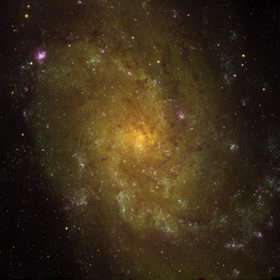This photograph of the Triangulum galaxy (M33) was taken with the MMT Observatory´s new Megacam instrument, a 340-megapixel monster that some have described as a "turbocharged" household digital camera. M33 is a sister galaxy to the Milky Way. It lies about 2.4 million light-years from Earth and spans about twice the diameter of the full moon. Credit: N. Caldwell, B. McLeod, and A. Szentgyorgyi (SAO)
Sibling rivalry is alive and well in outer space. The Milky Way galaxy has two sister spirals competing for attention from photographers. The Andromeda galaxy usually wins the contest, posing frequently for cosmic portraits. In this new image from the MMT Observatory's 6.5-meter telescope, the second sister finally gets her due notice. Here, the Triangulum galaxy emerges from the shadows to reveal stunning swirls of stars and dust dotted with brilliant pink nebulae.
The new photograph of the Triangulum galaxy showcases the dazzling capabilities of MMT's new Megacam instrument. Megacam was developed at the Smithsonian Astrophysical Observatory (SAO) in Cambridge, Mass., under the direction of astronomer Brian McLeod. This state-of-the-art camera consists of 36 CCD chips, each of which contains 9 million picture elements (pixels), making Megacam one of the largest digital cameras in the world.
"Megacam is like a turbocharged household digital camera," said SAO astronomer Nelson Caldwell. "While a typical digital camera might have eight or nine megapixels, Megacam has 340 megapixels."
Caldwell and McLeod picked the Triangulum galaxy to be one of the first objects photographed by Megacam. This galaxy, also known as Messier 33 or M33 for its designation in the catalog compiled by Charles Messier, lies about 2.4 million light-years from Earth. It spans about twice the diameter of the full moon in the night sky. Although large, its light is diffuse, making it a challenging object to spot with the unaided eye. The view of M33 is best in binoculars or small telescopes at low magnification.
Newly formed blue stars and dark dusty patches outline the spiral arms of M33. Pink filaments of hydrogen gas mark regions of active star formation similar to the Milky Way's Orion Nebula. The eye-catching nebula at upper left in this image, designated NGC 604, stretches across an impressive 1,500 light-years and holds more than 200 hot, young stars that light it from within.
The Triangulum galaxy is the smallest of the three spirals in the local neighborhood, holding as much mass as 10-40 billion suns. In comparison, the Milky Way holds about 200 billion suns' worth of normal matter, while Andromeda is even heftier.
"Triangulum is not a colossal giant like the Milky Way or Andromeda," said Caldwell. "But it has a charm and beauty of its own that belies its junior citizen status."
The MMT telescope contains a primary mirror 256 inches (6.5 meters) in diameter, making it among the largest optical telescopes in the world. Astronomers use the MMT for various projects such as searching for extrasolar planets, making 3-d maps of galaxies in space, and finding quasars that existed when the universe was only one-tenth of its present age. SAO operates the MMT Observatory, located south of Tucson, Ariz., in partnership with the University of Arizona.
Source: Harvard-Smithsonian Center for Astrophysics
























